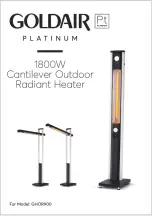
Automatic stove shutdown may occur in the following cases:
•
combustion chamber overheating
•
overflow
The
overflow
signal is generated by the bimetallic sensor located on the heat
exchanger. The contact opening signals that the threshold temperature value has been exceeded. The
control system switches the pump off, overheating is signalled by blinking red diode
OVERHEATING
on the control panel. Additionally, a sound signal is made. The heater fan operates until the furnace
emperature falls below 35°C. When this happens, the stove comes back to the
Stop
phase.
After the device has moved to the
Stop
phase (and even after disconnecting and reconnecting the
power supply) the overheating signal does not go out. This enables the user to determine the cause for
the stove shutdown. In order to switch the overheating signal off and bring the device to normal
operation, wait until the stove has cooled down (i.e. the fan has switched off) and press the button on
the casing of the bimetallic sensor. Then, press the
Stop
button, which will cause the heating diode
and the sound signal to turn off. The stove may now be switched on again.
The
overflow
signal is generated by the micro-switch located under the overflow
tank. The contact opening signals that the tank has overflowed. The control system switches
the pump off, overflowing is signalled by blinking red diode
OVERFLOW
on the control panel.
Additionally, a sound signal is made. The heater fan operates until the furnace temperature falls below
35°C. When this happens, the stove comes back to the
Stop
phase.
Then, remove the tank guard located on the side enclosure of the device, empty the overflow tank
and press the
Stop
button, which will cause the heating diode and the sound
signal to turn off. The stove may now be switched on again.
Fig. 6. The distribution of the heater safety components:
1. Control thermostat and STB thermostat
2. Overflow cut-out (micro-switch)





























